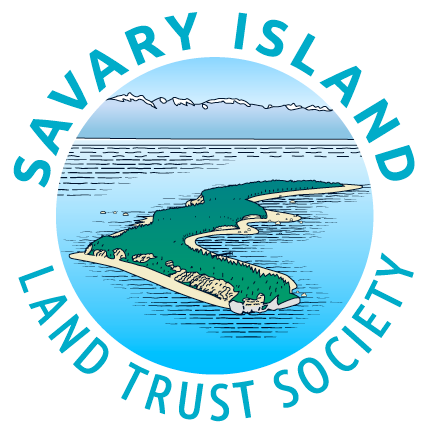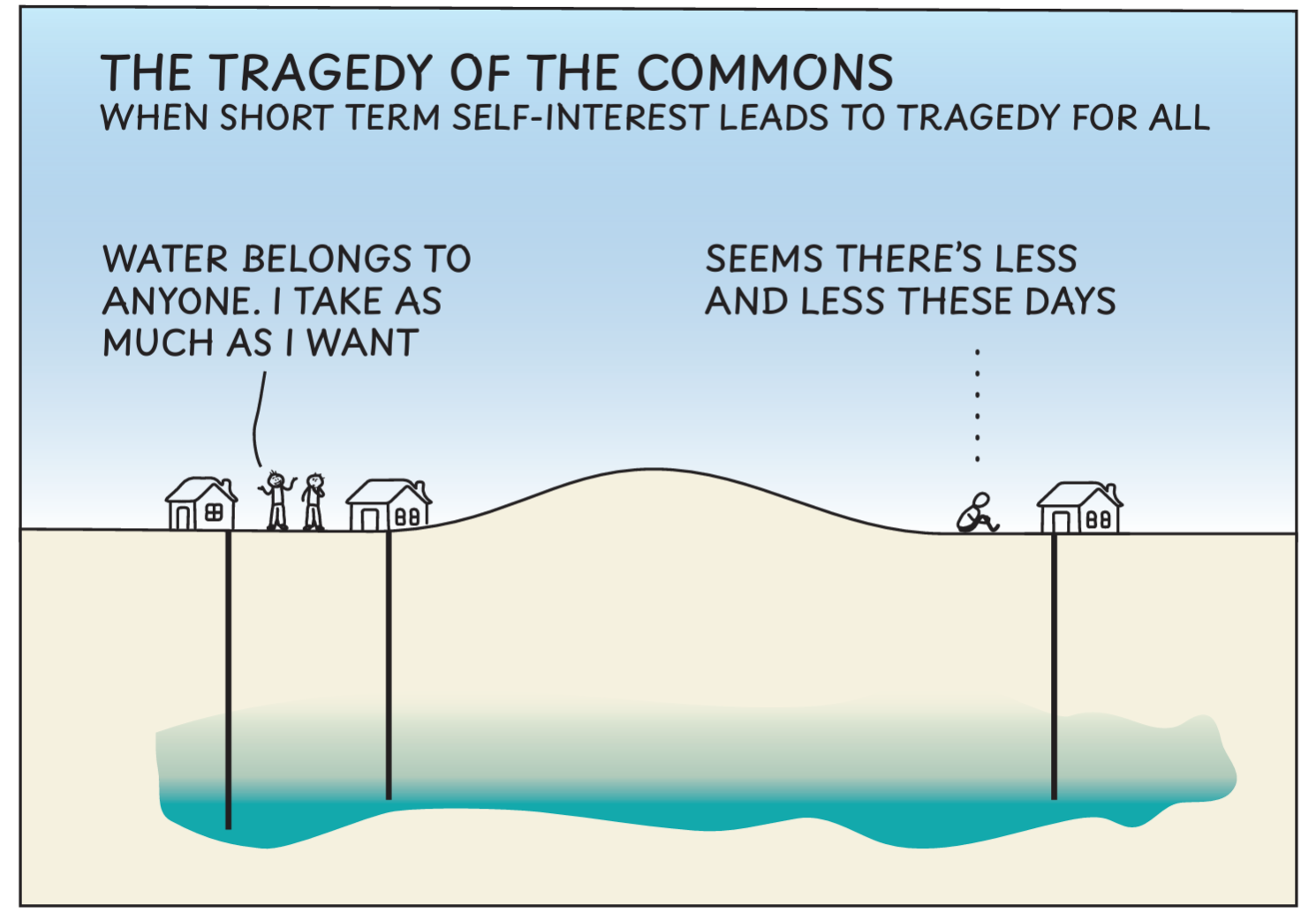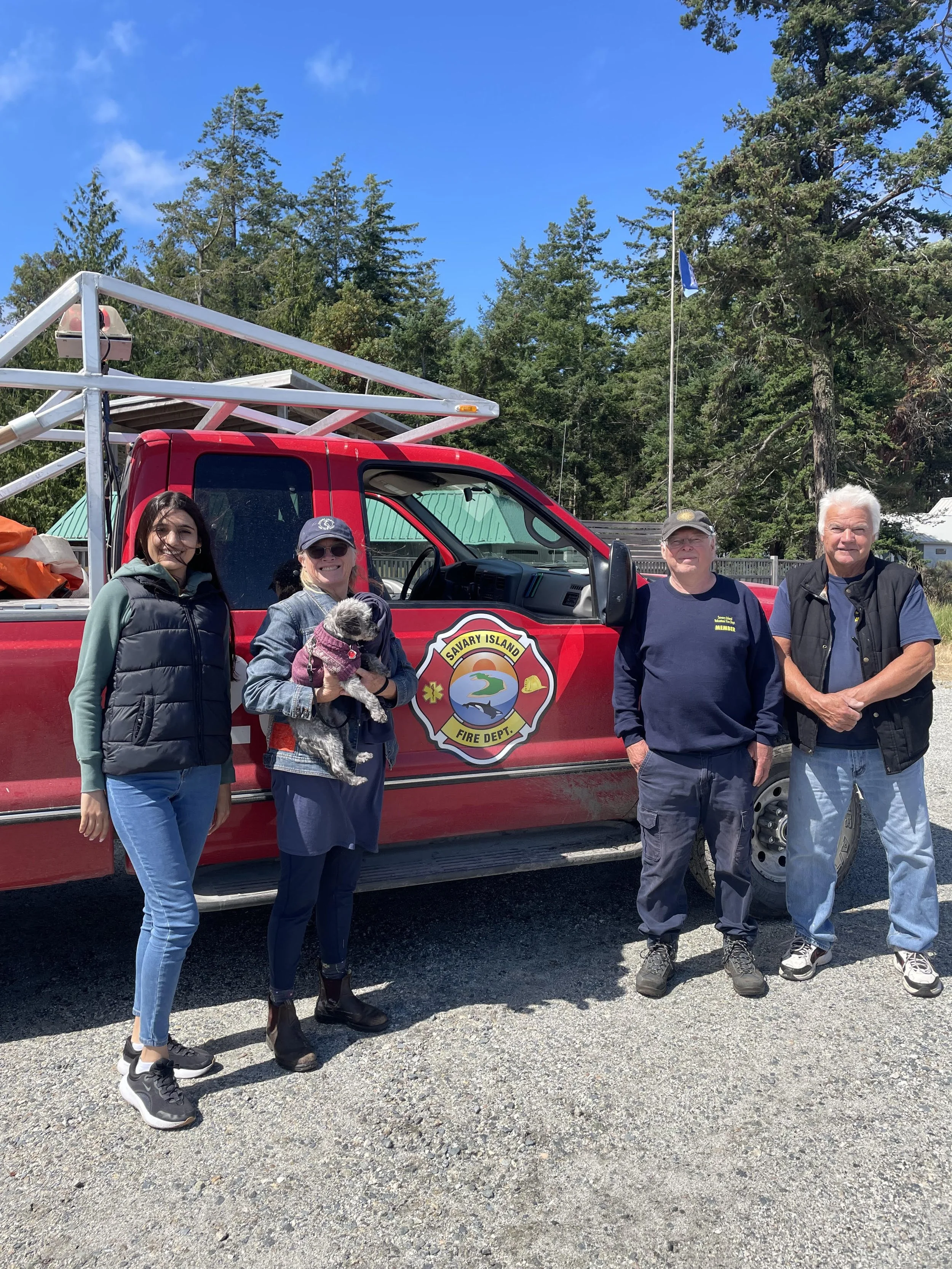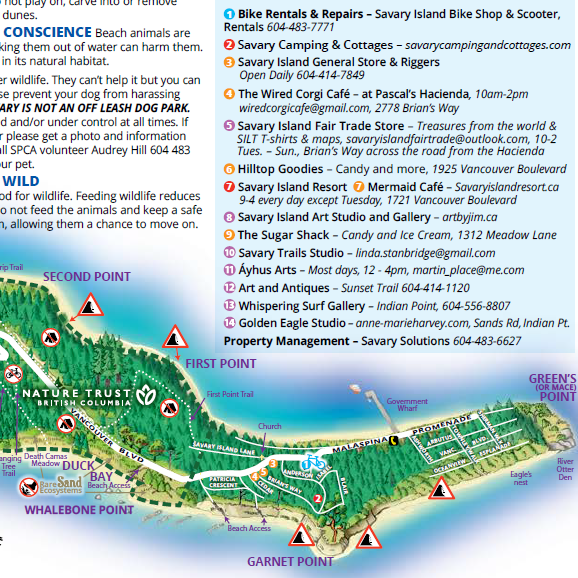Update: December 5, 2025
Savary Island Fire Detection Evaluation Committee (SIFDEC) Newsletter
Click here to read: November 2025 Update Newsletter
Update - November 4, 2025
Hello Savary Islanders,
According to a survey by the Association of the Savary Island Committee, the top 3 priorities of Savary Islanders are Fire - Water - Land.
Land has always been the focus of SILT's work, first with the Heart of Savary and then with subsequent gifts and acquisitions.Thanks to each of you, SILT has acquired and received conservation land on Savary for 30 years and continues to do so.
Thank you Savary Islanders for giving.
Water is second on the list of priorities of Savary Islanders according to the 2023 ASIC Survey and the SILT has taken a keen interest in it from our beginnings and shared your voices and concerns with authorities about protecting our groundwater for future generations. Public education about wells, septics and other development topics can be found in our Best Practices Guide.
In 2023 and 2024, SILT wrote to the qathet Regional District asking for a water study, a carrying capacity study and a tourism impact study as part of the OCP process. Several other Islanders wrote as well and shared the same or similar concerns about groundwater, island carrying capacity and tourism impacts.
SILT was pleased that the qRD invested in the water study research as a first step. The report Assessment of Groundwater Resources on Savary Island - Qayɛ qʷən was shared with OCP Advisory Committee Members in April.
It's a long and complicated report and the community has not yet had the opportunity to understand it. As an OCP Advisory Committee member, I requested that the study be presented to the community in face to face sessions in the summer before the key directions engagements and survey, in order to support informed decision making.
On October 28 and October 30, Planning Staff hosted webinars to share more information on the Assessment of Groundwater Resources on Savary Island – Qayɛ qʷən and the Savary Island Slope Hazard Study.
The QRD technical report presentations are available online here: www.qathet.ca/savaryocp
As our community moves forward, it is important we contemplate the impact of increased development on the carrying capacity of this small island.
The urban subdivision of the island into 1700 parcels more than a century ago has made density the most challenging issue for the long term sustainability of Savary Island. SILT has pursued several initiatives over the years to help address this by providing grants to property owners for lot consolidation, educational resources for building with the Best Practices Guide and the acquisition of approximately 400 acres on Savary Island over 30 years.
Based on the Key Directions Surveys this summer, 48.8% of survey respondents are in support of increased density responding in support of more than one dwelling per parcel.
We need to work together to make sure Savary doesn’t become a Tragedy of the Commons.
Many are familiar with this theory that describes a situation where individuals, acting independently and in their own self-interest, deplete a shared, limited resource because the individual receives the full benefit of using the resource, while the costs of depletion are distributed among everyone sharing it.
Savary water and land needs our protection and preservation now more than ever.
Sincerely,
Liz Webster, Executive Director, Savary Island Land Trust
September 14, 2025 - Click here to read the FAQs that Savary Islanders had for the Savary Island Fire Detection Evaluation Committee.
Thursday August 21, 2025 - Read the final report of the Savary Island Fire Detection Evaluation Committee by clicking here.
Happy Summer Friday to all,
I am super excited to update you about the chance to get first rate technology for Early Fire Protection on Savary Island. According to the ASIC survey of 2023, the top priority of Savary Islanders is FIRE, followed by WATER and the protection of Natural Areas.
This is going to be a game changer for public safety and conservation. Please consider the information and donate before August 17.
At the July 5, 2025, ASIC AGM, a motion was proposed by Peter Armstrong and seconded by me to form a committee to explore whether fire detection technology would work on Savary and, if so, how our community could fund it. The SIFDEC committee, Peter Armstrong, Liz Webster, Nancy Zoehner, Brian Craddock, SIVFD Chief, Chris Philpot, and SIVFD Deputy Chief, Doug Corbett—has been hard at work researching the options, with technical support from retired Professor, Ron Johnston, Rick Bell, and insurance guidance from Sandy Millar. Our efforts began on July 5 to determine the best technology available and raise the funds needed. Our technical group has researched several options and endorsed the SenseNet technology as the most effective for our community.
Please take a few minutes, learn more and see for yourself how the technology works.
If you scroll down on this page, you will see a video from an Island Zoom on July 22 explaining the project and showing how it works. The session was valuable to gain insight on the technology and the benefits of the application for Savary. Fair to say that most of those in attendance were very impressed. Sensenet is a strong risk management tool that is currently protecting a million acres and will improve fire fighting outcomes.
This is not a prototype, it is a proven product. SenseNet has been around for more than 5 years, and is protecting over 1 million acres today. SenseNet is at Predator Ridge, the city of Vernon, Harrison Hotsprings and on Vancouver Island with many satisfied clients. SenseNet detects and reports fire in minutes and is a strong risk management tool that will improve fire fighting outcomes. As a result of the ZOOM presentation and research done, we believe this technology will be an invaluable tool for the SIVFD, enabling faster detection and response times before fires get out of control. This ultimately will benefit all of Savary residents.
SenseNet representative, Leila Verjee and technology expert Brian Craddock visited Savary last week and toured the island with the Fire Chief, Chris Philpot and Deputy Chief Doug Corbett and myself to consider possible camera installations. Afterwards, a meeting was held with Committee members, Peter Armstrong and Nancy Zohner at the Main Firehall. At first, the idea was to have SenseNet cameras on Savary, however, after the reconnaissance trip last week, it seems that on island sensors and 3 off island cameras will provide the best coverage. This means less impact on Savary, as the cameras require a lot of infracture. The sensors are small and simply strapped to trees in specific locations to create a net of protection.
Here is link to questions posed by Savary Residents to the Savary Island Fire Detection Evaluation Committee (SIFDEC) about the process that got us to this point.
Here is a link to the full SenseNet Frequently Asked Questions. A selection of these questions is included below.
How does SenseNet ensure the accuracy of fire detection?
SenseNet ensures high accuracy in fire detection by combining advanced sensors with AI-driven analytics. We also cross-verify data with camera and satellite feeds, creating a comprehensive approach that strengthens our overall monitoring capabilities.
Can the system detect wildfires at night or in poor visibility conditions?
Yes, our system is equipped with powerful detection capabilities, whether through sensors or cameras. Our cameras are equipped with infrared imaging and AI algorithms, allowing them to detect wildfires even at night. In conditions of poor visibility, such as rain, fog, or clouds, our sensors are highly sensitive to changes in atmospheric composition, enabling detection without the need for visual confirmation.
How does SenseNet contribute to environmental conservation?
SenseNet contributes to environmental conservation by enabling early detection and efficient wildfire management, helping to protect natural habitats and wildlife. By reducing the carbon footprint of large-scale fires, it also provides a sense of security and protection for at-risk ecosystems
SenseNet Rep Leila Verjee, SILT Executive Director Liz Webster, SIVFD Deputy Chief Doug Corbett and SIVFD Fire Chief Chris Phipot on Island tour August 6, 2025
Can the sensors distinguish different sources of gases?
Yes, our sensor nodes are equipped with multiple sensors capable of distinguishing between various gases. They can differentiate between emissions from campfires, wildfires, and other non-fire-related sources. Additionally, they assess air pressure, humidity, temperature, particulate matter concentrations, volatile organic compounds, and overall air quality. Customizable add-ons, such as thermal sensing, are also available for enhanced detection
As the Asst Deputy Fire Chief, said, "we all know we are going to have a fire, we need to have the tools to be able to react quickly." Waiting is not a good strategy. Let's support the SIVFD with the best tools available to protect us. Because early fire detection aligns with our conservation goals, the SILT board passed a motion that SILT would help to raise the funds. The fundraising has been underway for a few weeks and we now have $220,000 in pledges and donations towards the $375,000 goal.
We believe that this is the right thing for Savary, and we are looking for island-wide support to help achieve the goal of installation in 2025. Each contribution is vital, regardless of size, as all of us will benefit. All donations to the initiative are tax-deductible through the SILT. We have established a SenseNet Donation Link on our Canada Helps site and on our website. To contribute, please click here and select option three: Savary Island Early Fire Detection Technology. Each donation will receive a tax receipt.
Thanks for a fabulous summer.
Liz Webster
Executive Director
Savary Island Land Trust Society
Read the rest of the newsletter here.
Fabulous Live Auction July 26
Official Community Plan and Savary Sustainability
Early Fire Detection Research Motion
MOTION PASSED at ASIC AGM on July 5th. 90 in support, 7 opposed.
Identifying Fires Before They Get Too Large
Dear ASIC Board of Directors:
Liz Webster and I respectfully submit the attached motion for consideration by the ASIC AGM 2025.
Fire Detection Technology Research Motion
Rationale for the Motion is to investigate the viability and capabilities of Fire Detection technology to understand if is appropriate for Savary Island. And if it is a viable technology then propose how to operate and pay for the equipment.
Motion:
Whereas Savary Island has massive number of trees, over 800 homes/structures and limited firefighting resources, with all citizens, forests and buildings being at risk from fires from natural or human causes, our community needs to investigate if new fire detecting technologies provide any additional protection worth the expense.
Be it resolved that ASIC in conjunction with the SIVFD, the regional district and residents establish a citizens committee of up to five people, to investigate what new technologies exist and if any are appropriate to increase the safety against fires on our island. Specifically the citizen committee will report out through ASIC on their findings. The findings should include, but not limited to,
What technologies exist, their operating experience and capabilities,
Are any fire detection technologies appropriate for Savary Island,
The thoughts of the SIVFD, ASIC, the regional district and any other organization that may provide advice, oversight, possible approval and possible source of funding,
Establish the projected capital costs and ongoing operating, maintenance costs of such technologies,
Recommendations as to how to fund the fire detection system, capital costs, operating costs and possible future upgrades.
And any other issues, concerns or opportunities related to the fire detection system.
This citizen committee while researching all aspects of the technologies will only make its finding known so that the appropriate authority can determine next steps.
The citizen committee should be all volunteer, with individuals that have the time, commitment to work on this project, represent the broader community, with special focus on fire fighting needs, skills to evaluate the technology and experience on fund raising.
The committee should report out to the ASIC community within 45 days of this motion passing.
So moved.
Peter Armstrong and Liz Webster
ABOUT US
The Savary Island Land Trust (SILT) was established in 1997, with the goal of preserving the last undivided and undeveloped wilderness on Savary (DL1375).
What We’ve Accomplished
In 1997 there was no conservation land on Savary. Today, 43% of the island is protected. Look at the map of all conservation lands here.
Take Action
Ready to take the next step? You can become a member, volunteer or donate to help preserve Savary Island now, and for future generations.
NewsLetters
Read about SILT events, conservation milestones and community, as well as the natural history of Savary.
Resources For Visitors
The Savary Visitor’s Map is designed to provide useful information about how to enjoy the island sustainably.
Resources for Savary Islanders
Includes maps and information on: the Official Community Plan; how to connect with local government; best practices regarding building, groundwater, transportation, and tree-removal.
Natural History of Savary Island
Learn about the plants, animals and geological history of Savary here.
Our Story
In 1995 a group of concerned Savary Islanders joined together with the goal to save the Heart of Savary - the last undivided and undeveloped wilderness on Savary - from becoming a gated community development. They established the Savary Island Land Trust Society in 1997. In 1998 SILT became a charity and received its first gifts of land. Since that time, SILT has acquired 23 lots across the island and nearly 43% of Savary is protected. Our successes are rooted in the vision of our founders, and the commitment of our donors, members, artists and volunteers.
We never lost sight of our first goal: the Heart of Savary. It took 22 years and the efforts and generosity of many islanders, the Friends of Savary, and SILT to raise the funds for the Nature Trust of BC to acquire the land for conservation in 2018. Thanks to each and everyone who helped and contributed to this community achievement.
Savary is the most ecologically rare and has the highest density of subdivision of any of the islands in the Salish Sea. Protecting wetlands, dunes, forests, meadows, springs and groundwater remain critical to the biodiversity and sustainability of the Island. In 2019, the Savary Island Nature Legacy Fund for land conservation was established with a gift from the Armstrong Family Foundation. Since that time, it has grown to $75,000. To donate click here.
To celebrate 25 years of SILT in 2022, we set up the the Savary Island Sustainability Fund. A donation to this fund will help SILT continue to protect nature on Savary, and offer stewardship education and activities to nurture a sense of place and connection for Savary Islanders now and into the future. To donate, please click here.














